本文实例为大家分享了ios获取通讯录的4种方式,供大家参考,具体内容如下
使用场景
一些app通过手机号码来推荐好友,如 微博、支付宝
首先客户端会获取通讯录中的所有手机号然后将这些手机号提交到app服务器中,服务器会查找每个手机号对应的app账号如qq号码返回到客户端,然后客户端根据服务器返回的账号列表来推荐好友。
获取联系人方式
方案一:addressbookui.framework框架
提供了联系人列表界面、联系人详情界面、添加联系人界面等
一般用于选择联系人
方案二:addressbook.framework框架:
没有提供ui界面,需要自己搭建联系人界面
纯c语言的api, 仅仅是获得联系人数据
大部分数据类型是core foundation
从ios6 开始,需要得到用户的授权才能访问通讯录
方案三:第三方框架:rhaddressbook
对 addressbook.framework 进行封装
方案四:ios9.0最新通讯录框架
contactsui.framework : 方案1的替代品,特点: 面向对象,使用简单,有界面
contacts.framework: 方案2的替代品, 特点:面向对象,使用简单,五界面
方案一:addressbookui.framework
实现步骤:
1.创建选择联系人的控制器
2.设置代理:用来接收用户选择的联系人信息
3.弹出联系人控制器
4.实现代理方法
5.在对应的代理方法中获取联系人信息
addressbook.frame实现步骤:
1.请求授权
2.判断授权状态如果已授权则继续,如果未授权则提示用户
3.创建通讯录对象
4.从通讯录中获取所有的联系人
5.遍历所有的联系人
6.释放不再使用的对象
addreesbook.framework具体实现:
1. appdelegate 应用启动时请求授权
|
1
2
3
4
5
6
7
8
9
10
11
12
13
14
15
16
17
18
19
20
21
22
23
24
25
26
27
28
29
30
31
32
33
|
#import "appdelegate.h"#import <addressbook/addressbook.h>@interface appdelegate ()@end@implementation appdelegate- (bool)application:(uiapplication *)application didfinishlaunchingwithoptions:(nsdictionary *)launchoptions { // override point for customization after application launch. [self requestauthorizationaddressbook]; return yes;}- (void)requestauthorizationaddressbook { // 判断是否授权 abauthorizationstatus authorizationstatus = abaddressbookgetauthorizationstatus(); if (authorizationstatus == kabauthorizationstatusnotdetermined) { // 请求授权 abaddressbookref addressbookref = abaddressbookcreate(); abaddressbookrequestaccesswithcompletion(addressbookref, ^(bool granted, cferrorref error) { if (granted) { // 授权成功 } else { // 授权失败 nslog(@"授权失败!"); } }); }}@end |
2. ios10 需要在info.plist配置nscontactsusagedescription
|
1
2
|
<key>nscontactsusagedescription</key><string>请求访问通讯录</string> |
3. viewcontroller
|
1
2
3
4
5
6
7
8
9
10
11
12
13
14
15
16
17
18
19
20
21
22
23
24
25
26
27
28
29
30
31
32
33
34
35
36
37
38
39
40
41
42
43
44
45
46
47
48
49
50
51
52
53
54
55
56
57
58
59
60
61
62
63
64
65
66
67
68
69
70
71
72
73
74
75
76
77
78
79
80
81
82
83
84
85
86
87
88
89
90
91
92
93
94
95
96
97
98
99
100
101
102
103
104
105
106
107
108
109
110
111
112
113
114
115
116
117
118
119
120
121
122
123
124
|
#import "viewcontroller.h"#import <addressbook/addressbook.h>@interface viewcontroller ()@end@implementation viewcontroller- (void)viewdidload { [super viewdidload];}- (void)touchesbegan:(nsset<uitouch *> *)touches withevent:(uievent *)event { // 1. 判读授权 abauthorizationstatus authorizationstatus = abaddressbookgetauthorizationstatus(); if (authorizationstatus != kabauthorizationstatusauthorized) { nslog(@"没有授权"); return; } // 2. 获取所有联系人 abaddressbookref addressbookref = abaddressbookcreate(); cfarrayref arrayref = abaddressbookcopyarrayofallpeople(addressbookref); long count = cfarraygetcount(arrayref); for (int i = 0; i < count; i++) { //获取联系人对象的引用 abrecordref people = cfarraygetvalueatindex(arrayref, i); //获取当前联系人名字 nsstring *firstname=(__bridge nsstring *)(abrecordcopyvalue(people, kabpersonfirstnameproperty)); //获取当前联系人姓氏 nsstring *lastname=(__bridge nsstring *)(abrecordcopyvalue(people, kabpersonlastnameproperty)); nslog(@"--------------------------------------------------"); nslog(@"firstname=%@, lastname=%@", firstname, lastname); //获取当前联系人的电话 数组 nsmutalearray *phonearray = [[nsmutablearray alloc]init]; abmultivalueref phones = abrecordcopyvalue(people, kabpersonphoneproperty); for (nsinteger j=0; j<abmultivaluegetcount(phones); j++) { nsstring *phone = (__bridge nsstring *)(abmultivaluecopyvalueatindex(phones, j)); nslog(@"phone=%@", phone); [phonearray addobject:phone]; } //获取当前联系人的邮箱 注意是数组 nsmutablearray *emailarray = [[nsmutablearray alloc]init]; abmultivalueref emails= abrecordcopyvalue(people, kabpersonemailproperty); for (nsinteger j=0; j<abmultivaluegetcount(emails); j++) { nsstring *email = (__bridge nsstring *)(abmultivaluecopyvalueatindex(emails, j)); nslog(@"email=%@", email); [emailarray addobject:email]; }//获取当前联系人中间名 nsstring *middlename=(__bridge nsstring*)(abrecordcopyvalue(people, kabpersonmiddlenameproperty)); //获取当前联系人的名字前缀 nsstring *prefix=(__bridge nsstring*)(abrecordcopyvalue(people, kabpersonprefixproperty)); //获取当前联系人的名字后缀 nsstring *suffix=(__bridge nsstring*)(abrecordcopyvalue(people, kabpersonsuffixproperty)); //获取当前联系人的昵称 nsstring *nickname=(__bridge nsstring*)(abrecordcopyvalue(people, kabpersonnicknameproperty)); //获取当前联系人的名字拼音 nsstring *firstnamephoneic=(__bridge nsstring*)(abrecordcopyvalue(people, kabpersonfirstnamephoneticproperty)); //获取当前联系人的姓氏拼音 nsstring *lastnamephoneic=(__bridge nsstring*)(abrecordcopyvalue(people, kabpersonlastnamephoneticproperty)); //获取当前联系人的中间名拼音 nsstring *middlenamephoneic=(__bridge nsstring*)(abrecordcopyvalue(people, kabpersonmiddlenamephoneticproperty)); //获取当前联系人的公司 nsstring *organization=(__bridge nsstring*)(abrecordcopyvalue(people, kabpersonorganizationproperty)); //获取当前联系人的职位 nsstring *job=(__bridge nsstring*)(abrecordcopyvalue(people, kabpersonjobtitleproperty)); //获取当前联系人的部门 nsstring *department=(__bridge nsstring*)(abrecordcopyvalue(people, kabpersondepartmentproperty)); //获取当前联系人的生日 nsstring *birthday=(__bridge nsdate*)(abrecordcopyvalue(people, kabpersonbirthdayproperty)); //获取当前联系人的备注 nsstring *notes=(__bridge nsstring*)(abrecordcopyvalue(people, kabpersonnoteproperty)); //获取创建当前联系人的时间 注意是nsdate nsdate *creattime=(__bridge nsdate*)(abrecordcopyvalue(people, kabpersoncreationdateproperty)); //获取最近修改当前联系人的时间 nsdate *altertime=(__bridge nsdate*)(abrecordcopyvalue(people, kabpersonmodificationdateproperty)); //获取地址 abmultivalueref address = abrecordcopyvalue(people, kabpersonaddressproperty); for (int j=0; j<abmultivaluegetcount(address); j++) { //地址类型 nsstring *type = (__bridge nsstring *)(abmultivaluecopylabelatindex(address, j)); nsdictionary * tempdic = (__bridge nsdictionary *)(abmultivaluecopyvalueatindex(address, j)); //地址字符串,可以按需求格式化 nsstring *adress = [nsstring stringwithformat:@"国家:%@\n省:%@\n市:%@\n街道:%@\n邮编:%@",[temdic valueforkey:(nsstring*)kabpersonaddresscountrykey],[tempdic valueforkey:(nsstring*)kabpersonaddressstatekey],[tempdic valueforkey:(nsstring*)kabpersonaddresscitykey],[tempdic valueforkey:(nsstring*)kabpersonaddressstreetkey],[tempdic valueforkey:(nsstring*)kabpersonaddresszipkey]]; } //获取当前联系人头像图片 nsdata *userimage=(__bridge nsdata*)(abpersoncopyimagedata(people)); //获取当前联系人纪念日 nsmutablearray *datearr = [[nsmutablearray alloc]init]; abmultivalueref dates= abrecordcopyvalue(people, kabpersondateproperty); for (nsinteger j=0; j<abmultivaluegetcount(dates); j++) { //获取纪念日日期 nsdate *data =(__bridge nsdate*)(abmultivaluecopyvalueatindex(dates, j)); //获取纪念日名称 nsstring *str =(__bridge nsstring*)(abmultivaluecopylabelatindex(dates, j)); nsdictionary *tempdic = [nsdictionary dictionarywithobject:data forkey:str]; [datearr addobject:tempdic]; } }}@end |
4. 运行结果
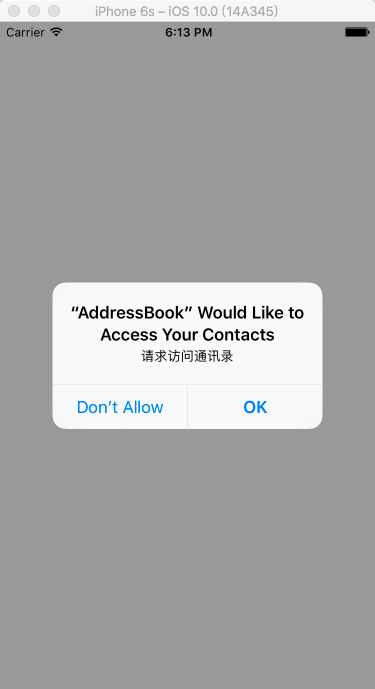
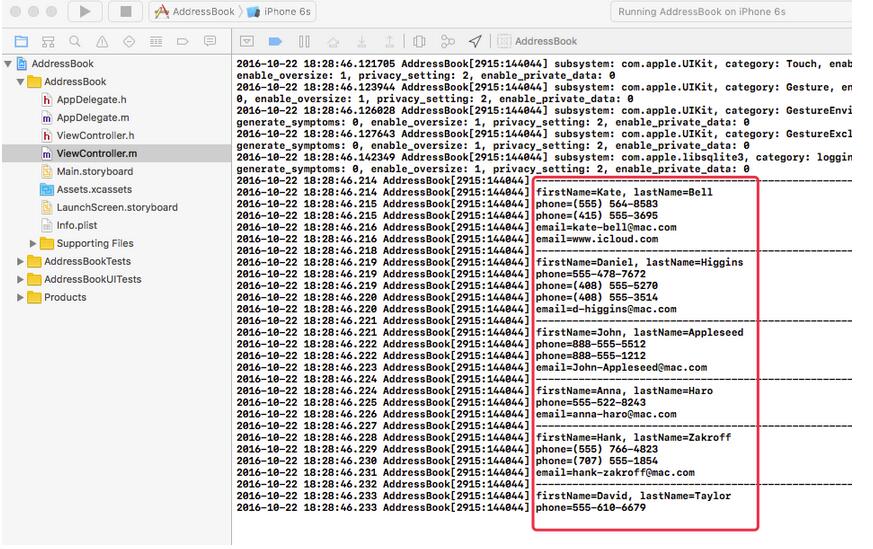
第三方框架:rhaddressbook
https://github.com/heardrwt/rhaddressbook
该框架使用的mrc来管理内存的,如果直接将源代码拖入进去需要为每个文件设置编译标记:-fno-objc-arc, 设置完还会报错,该项目使用的一些方法过于古老,很多都不支持了,所以这种方式不采用; 可以将该项目打成静态库的方式;也可以直接将项目拖入到自己的工程中作为一个依赖
1.直接将rhaddressbook.xcodeproj拖入到工程中
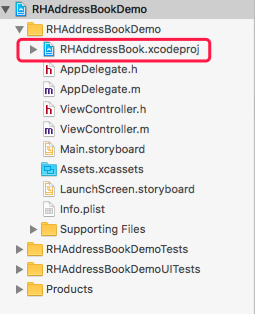
2.添加target dependencies和link binary with libraries
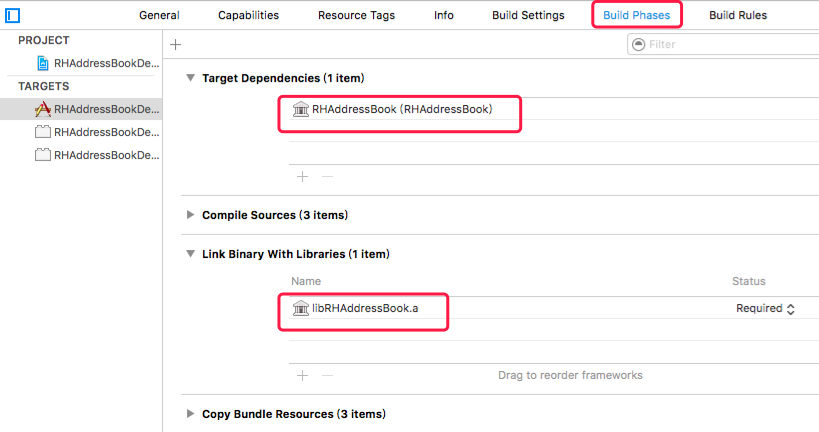
3.build settings—> other linker flags : -objc
用于解决系统分类找不到方法的错误

4.ios10 需要在info.plist配置nscontactsusagedescription
|
1
2
|
<key>nscontactsusagedescription</key><string>请求访问通讯录</string> |
app启动时请求授权访问通讯录
|
1
2
3
4
5
6
7
8
9
10
11
12
13
14
15
16
17
18
19
20
21
22
23
24
25
26
27
28
29
30
|
#import "appdelegate.h"#import <rhaddressbook/rhaddressbook.h>@interface appdelegate ()@end@implementation appdelegate- (bool)application:(uiapplication *)application didfinishlaunchingwithoptions:(nsdictionary *)launchoptions { // override point for customization after application launch. [self requestauthorizationforaddressbook]; return yes;}- (void)requestauthorizationforaddressbook { rhaddressbook *ab = [[rhaddressbook alloc] init]; if ([rhaddressbook authorizationstatus] == rhauthorizationstatusnotdetermined){ [ab requestauthorizationwithcompletion:^(bool granted, nserror *error) { if (granted) { } else { nslog(@"请求授权拒绝"); } }]; }}@end |
获取所有联系人的信息:姓名、手机号等
|
1
2
3
4
5
6
7
8
9
10
11
12
13
14
15
16
17
18
19
20
21
22
23
24
25
26
27
28
29
30
31
32
33
34
35
36
37
|
#import "viewcontroller.h"#import <rhaddressbook/rhaddressbook.h>#import <rhaddressbook/addressbook.h>@interface viewcontroller ()@end@implementation viewcontroller- (void)viewdidload { [super viewdidload];}- (void)touchesbegan:(nsset<uitouch *> *)touches withevent:(uievent *)event { rhaddressbook *addressbook = [[rhaddressbook alloc] init]; if ([rhaddressbook authorizationstatus] != rhauthorizationstatusauthorized){ nslog(@"没有授权"); return; } nsarray *peoplearray= addressbook.people; for (int i = 0; i < peoplearray.count; i++) { rhperson *people = (rhperson *)peoplearray[i]; nslog(@"%@", people.name); rhmultistringvalue *phonenumbers = people.phonenumbers; for (int i = 0; i < phonenumbers.count; i++) { nsstring* label= [phonenumbers labelatindex:i]; nsstring* value= [phonenumbers valueatindex:i]; nslog(@"label=%@, value=%@", label, value); } nslog(@"----------------------------------------------"); }}@end |
运行结果:
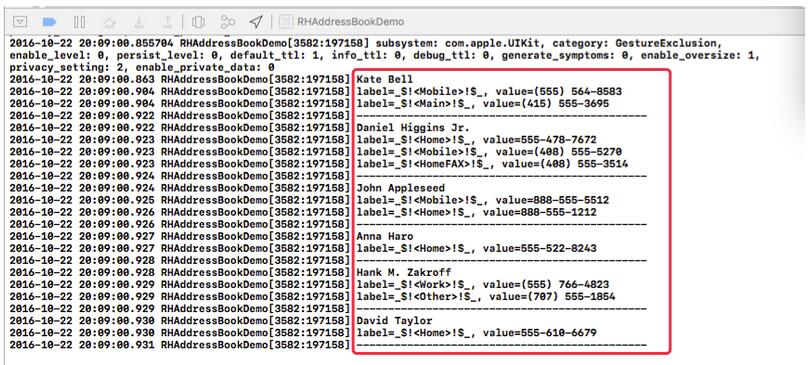
contactsui.framework
|
1
2
3
4
5
6
7
8
9
10
11
12
13
14
15
16
17
18
19
20
21
22
23
24
25
26
27
28
29
30
31
32
33
34
35
36
37
38
39
40
41
42
43
44
45
46
47
48
49
50
51
|
#import "viewcontroller.h"#import <contactsui/contactsui.h>@interface viewcontroller () <cncontactpickerdelegate>@end@implementation viewcontroller- (void)viewdidload { [super viewdidload]; cncontactpickerviewcontroller *contactpickerviewcontroller = [[cncontactpickerviewcontroller alloc] init]; contactpickerviewcontroller.delegate = self; [self presentviewcontroller:contactpickerviewcontroller animated:yes completion:nil];}// 如果实现该方法当选中联系人时就不会再出现联系人详情界面, 如果需要看到联系人详情界面只能不实现这个方法,- (void)contactpicker:(cncontactpickerviewcontroller *)picker didselectcontact:(cncontact *)contact { nslog(@"选中某一个联系人时调用---------------------------------"); [self printcontactinfo:contact];}// 同时选中多个联系人- (void)contactpicker:(cncontactpickerviewcontroller *)picker didselectcontacts:(nsarray<cncontact *> *)contacts { for (cncontact *contact in contacts) { nslog(@"================================================"); [self printcontactinfo:contact]; }}- (void)printcontactinfo:(cncontact *)contact { nsstring *givenname = contact.givenname; nsstring *familyname = contact.familyname; nslog(@"givenname=%@, familyname=%@", givenname, familyname); nsarray * phonenumbers = contact.phonenumbers; for (cnlabeledvalue<cnphonenumber*>*phone in phonenumbers) { nsstring *label = phone.label; cnphonenumber *phonnumber = (cnphonenumber *)phone.value; nslog(@"label=%@, value=%@", label, phonnumber.stringvalue); }}// 注意:如果实现该方法,上面那个方法就不能实现了,这两个方法只能实现一个//- (void)contactpicker:(cncontactpickerviewcontroller *)picker didselectcontactproperty:(cncontactproperty *)contactproperty {// nslog(@"选中某个联系人的某个属性时调用");//}@end |
选择单个联系人时运行效果:


选择多个联系人的界面:


contact.framework
ios10 需要在info.plist配置nscontactsusagedescription
|
1
2
|
<key>nscontactsusagedescription</key><string>请求访问通讯录</string> |
应用启动时请求授权:
|
1
2
3
4
5
6
7
8
9
10
11
12
13
14
15
16
17
18
19
20
21
22
23
24
25
26
27
28
29
30
31
32
|
#import "appdelegate.h"#import <contacts/contacts.h>@interface appdelegate ()@end@implementation appdelegate- (bool)application:(uiapplication *)application didfinishlaunchingwithoptions:(nsdictionary *)launchoptions { // override point for customization after application launch. [self requestauthorizationforaddressbook]; return yes;}- (void)requestauthorizationforaddressbook { cnauthorizationstatus authorizationstatus = [cncontactstore authorizationstatusforentitytype:cnentitytypecontacts]; if (authorizationstatus == cnauthorizationstatusnotdetermined) { cncontactstore *contactstore = [[cncontactstore alloc] init]; [contactstore requestaccessforentitytype:cnentitytypecontacts completionhandler:^(bool granted, nserror * _nullable error) { if (granted) { } else { nslog(@"授权失败, error=%@", error); } }]; }}@end |
获取通讯录信息
|
1
2
3
4
5
6
7
8
9
10
11
12
13
14
15
16
17
18
19
20
21
22
23
24
25
26
27
28
29
30
31
32
33
34
35
36
37
38
39
40
41
42
43
44
|
#import "viewcontroller.h"#import <contacts/contacts.h>@interface viewcontroller ()@end@implementation viewcontroller- (void)viewdidload { [super viewdidload];}- (void)touchesbegan:(nsset<uitouch *> *)touches withevent:(uievent *)event { cnauthorizationstatus authorizationstatus = [cncontactstore authorizationstatusforentitytype:cnentitytypecontacts]; if (authorizationstatus == cnauthorizationstatusauthorized) { nslog(@"没有授权..."); } // 获取指定的字段,并不是要获取所有字段,需要指定具体的字段 nsarray *keystofetch = @[cncontactgivennamekey, cncontactfamilynamekey, cncontactphonenumberskey]; cncontactfetchrequest *fetchrequest = [[cncontactfetchrequest alloc] initwithkeystofetch:keystofetch]; cncontactstore *contactstore = [[cncontactstore alloc] init]; [contactstore enumeratecontactswithfetchrequest:fetchrequest error:nil usingblock:^(cncontact * _nonnull contact, bool * _nonnull stop) { nslog(@"-------------------------------------------------------"); nsstring *givenname = contact.givenname; nsstring *familyname = contact.familyname; nslog(@"givenname=%@, familyname=%@", givenname, familyname); nsarray *phonenumbers = contact.phonenumbers; for (cnlabeledvalue *labelvalue in phonenumbers) { nsstring *label = labelvalue.label; cnphonenumber *phonenumber = labelvalue.value; nslog(@"label=%@, phone=%@", label, phonenumber.stringvalue); }// *stop = yes; // 停止循环,相当于break; }];}@end |
运行效果:


以上就是本文的全部内容,希望对大家的学习有所帮助,也希望大家多多支持服务器之家。
















